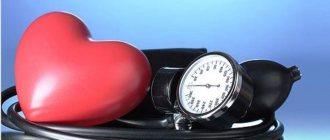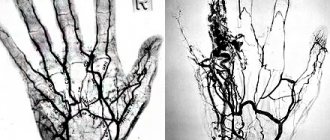Prolonged standing and excessive stress on the legs, as well as sedentary work, coupled with a sedentary lifestyle, lead to impaired blood supply in the lower extremities. This leads to a serious disease - varicose veins. This is not only a physiological ailment, but also a serious cosmetic defect in the form of a spider web of capillary mesh, as well as swollen wreaths and frequent bruising.
The first sign of poor circulation in the lower extremities is the appearance of nagging pain in the legs. To prevent further development of blood vessel pathology, you should make an appointment with a vascular surgeon. The specialist will prescribe an examination and provide timely treatment. This minimizes the risk of the need for surgical intervention.
What diseases does a vascular surgeon treat?
Basically, modern vascular surgeons specialize in performing minimally invasive surgical interventions (microsurgery). However, they are also involved in the full supervision of the patient - his rehabilitation and recovery, selection of conservative (in particular, preventive) treatment, correction of nutrition and lifestyle, dynamic monitoring of the state of the vascular system.
The angiosurgeon treats the following pathologies:
- Atherosclerosis in all forms and stages;
- Stroke and post-stroke disorders;
- Vascular malformations;
- Aortic aneurysm;
- Varicose veins;
- Myocardial infarction;
- IHD (coronary heart disease);
- Angina;
- Arterial or venous stenoses;
- Thrombosis (acute and chronic);
- Thrombophlebitis;
- Arteriovenous fistulas;
- Raynaud's syndrome;
- Buerger's disease (thromboangiitis obliterans);
- Angiopathy (including diabetic);
- Aortoarteritis;
- Arteritis and polyarteritis;
- Vasculitis;
- Endarteritis;
- Vascular hypertension (hypertension);
- Trophic ulcers;
- Lymphedema (lymphostasis).
Detection of symptomatic manifestations of one or more of these diseases should prompt you to seek professional medical help. Observation and treatment by competent vascular surgeons will significantly improve your quality of life.
Modern methods of vascular surgery
Vascular surgeons at the Yusupov Hospital in many cases prefer the safest and most gentle methods of surgery without incisions. Surgical interventions are performed through small punctures in the skin up to 4 mm in diameter under the control of modern X-ray or ultrasound equipment. When performing interventions on blood vessels, in most cases there is no need to use anesthesia.
Vascular surgeons use the following gentle surgical techniques, which are minimally traumatic, highly effective and do not require a long rehabilitation period:
- Vascular embolization is a method used for bleeding. The angiosurgeon introduces special adhesives, plastic particles into the lumen of the vessel using a catheter, or performs cauterization;
- A stent graft is a modern endoprosthesis that is used to treat abdominal aortic aneurysm. It consists of a metal frame covered with synthetic fabric. The stent is inserted under general anesthesia through a small incision in the groin area;
- Y-shaped bifurcated stent-graft is used to treat aneurysms of the pelvic arteries. This innovative operation can be performed even on elderly patients over 80 years of age;
- Balloon angioplasty followed by stenting - a vascular surgeon inserts a special balloon into the area of narrowing of the vessel and inflates it. The balloon expands the narrowed area. To maintain the space, a stent is placed, which may sometimes be coated with drugs to prevent blood clots.
- Installation of a vena cava filter is a procedure by which detached blood clots that cannot enter the lungs or brain vessels are caught and stopped.
To make an appointment with a vascular surgeon (phlebologist) in Moscow, call. The contact center specialists at the Yusupov Hospital will offer a consultation time that is convenient for you.
When is it necessary to contact an angiosurgeon?
An appeal to vascular surgeons should take place in the presence of subjective complaints and suspicions of relevant pathologies.
Persons over 45-50 years of age should undergo regular scheduled examinations with cardiologists, phlebologists and angiosurgeons to prevent and timely detect possible vascular pathologies. This age category of patients is automatically included in the risk group for various venous and arterial diseases. This is especially true for those who lead an unhealthy lifestyle with bad habits, irrational nutrition and physical inactivity, as well as those who have provoking chronic diseases (diabetes mellitus, thrombophilia, etc.).
Contact your vascular surgeon if you notice the following symptoms:
- Severe swelling of the legs, especially in the evening or at night;
- Night cramps in the lower extremities;
- Feeling of heaviness, fullness, burning and itching in the calf muscles;
- Intermittent claudication;
- Fatigue of the legs with an objectively low load;
- The appearance of spider veins and protruding venous nodes on the legs;
- Regularly recurring headaches of unknown origin;
- Blood pressure disorders (hypo- or hypertension);
- Tendency to hypertensive crises;
- Changes in the shade and structure of the skin of the extremities (as well as ring pigmentation on the legs);
- Burning in the feet when walking long distances;
- Feeling of tingling, numbness and severe cooling of the extremities without objective reasons;
- Pulsation in the abdominal area;
- Spontaneous repeated fainting and syncope (short-term loss of consciousness);
- Transient paresis and paralysis;
- Loss of sensation in the upper or lower extremities;
- Constant dizziness and nausea;
- Visual disturbances (transient blindness, the appearance of floaters and light spots in the field of vision, peripheral vision disorder);
- Short-term disorders of speech functions;
- Unsteadiness of gait, frequent states of numbness;
- Blackening or blueness of fingers;
- Long-term non-healing wounds, fistulas and ulcers.
If such symptoms are present, the therapist can make a pointless diagnosis, so if they are detected, it is advisable to contact a highly specialized specialist. In addition to a vascular surgeon, we recommend that you consult a neurologist and cardiologist.
Vascular surgeons deal with both congenital and acquired diseases of the cardiovascular system.
What symptoms and situations require mandatory consultation with a specialist?
Patients often come to this specialist on a referral from their attending physician. Surgical intervention makes sense in cases where:
- treatment with conservative methods does not produce results;
- the patient contacted the doctor in the late stages of the disease;
- there is a congenital pathology and its mechanical correction is necessary.
Symptoms that patients usually complain about when visiting a cardiovascular surgeon:
- headaches not associated with fever or intoxication due to infectious diseases (usually long-lasting);
- the appearance of numbness in the limbs and other parts of the body, constant chilliness of the feet and hands, blueness of the fingers, the appearance of areas of redness with pain;
- persistent tinnitus;
- sharp deterioration of vision, decreased sharpness, appearance of dots and “spots” before the eyes;
- a feeling of heaviness in the legs, their swelling, protruding veins;
- spasmodic pain in the limbs when walking;
- venous “stars” on the legs;
- feeling of pulsation in the abdomen;
- sudden and repeated attacks of loss of consciousness, swaying when walking;
- frequent hemorrhages.
What does a specialist do?
A vascular surgeon works in the following areas:
- Diagnosis, treatment and prevention of vascular (arterial and venous) diseases;
- Timely detection of oncopathologies (when a malignant tumor is localized in close proximity to large vessels);
- Treatment of vascular lesions that occur due to severe injuries;
- Prosthetics of vessels damaged due to injury or surgery;
- Performing full and minor surgical interventions on veins and arteries;
- Removal of genetically determined vascular abnormalities (malformations, hemangiomas, etc.);
- Replantology (microsurgical intervention aimed at complete or partial reconstruction of limbs or their fragments after radical amputation);
- Prevention aimed at preventing the development of vascular diseases in patients at risk.
The prognosis of treatment directly depends on the degree of qualification of the specialist, his clinical experience, skills, as well as the timeliness of the patient’s contact with him.
Tell us about new directions in the treatment of such a terrible disease as aortic aneurysm?
The aorta is the largest and most powerful artery in the entire human body. The aorta originates from the left ventricle, from where oxygen-enriched blood enters it. Next, the blood passes through the aorta, entering all the arteries departing from it, supplying all organs and tissues. One of the diseases of the aorta is aneurysm. An aneurysm of the aorta and other arteries is a sac in some part of the artery that forms as a result of a weakening of its wall. An aneurysm can take several years to form. A “sword of Damocles” hangs over a person with an aneurysm; in other words, at any moment, life can end as a result of a rupture of the aneurysm sac.
At our center there is a program for treating patients with abdominal aortic aneurysms using endovascular replacement. This became possible thanks to our cooperation with vascular surgeons from the USA, who have already repeatedly performed demonstration operations for diseases of the aorta and peripheral arteries in the Department of Vascular Surgery. Endoprosthesis replacement of an abdominal aortic aneurysm can significantly expand the number of patients being operated on due to the minimally invasive technique, which in many cases allows the intervention to be performed under local anesthesia.
Appointment with an angiosurgeon
A consultation with a vascular surgeon does not require any special preparation. Before going to the clinic, take a hygienic shower and put on clean underwear. Don't forget to bring a medical card with your medical history.
During the interview, the specialist may need the results of previously conducted examinations and tests, so if you have any on hand, take them with you. Tell the specialist your family history if your closest blood relatives have had acute or chronic diseases of the veins or arteries.
For a full diagnosis and final diagnosis, you may be prescribed the following studies:
- Laboratory blood tests (general, biochemical, lipid profile, prothrombin time, detailed coagulogram, etc.);
- Electrocardiogram;
- Echocardiogram;
- Ultrasound duplex scanning of blood vessels;
- Doppler ultrasound;
- Angiography (including cerebral and coronary);
- Ultrasound, CT, MRI;
- Endoscopy;
- Sonography.
The specialist conducts anthropometry directly during a face-to-face visit (the patient’s height and weight, body mass index, body fat density, constitutional body type and other indicators are assessed).
The angiosurgeon may require the opinion of related specialized specialists, to whom he will refer you if necessary.
Treatment by a vascular surgeon
The decision regarding therapeutic tactics is made on the basis of the collected medical history, the results of additional studies, and the opinions of other specialists. The vascular surgeon evaluates the course of the disease, its form and causes (exogenous and endogenous). When choosing any treatment method, possible contraindications and limitations are taken into account.
Typically, vascular treatment becomes combined and combines conservative and surgical therapy.
After completing the main treatment, angiosurgeons begin preventive measures. In order to prevent relapses and complications, physiotherapy, physical therapy, and massages are used in clinical practice. The patient is prescribed the required degree of compression. The supervising specialist gives the patient recommendations regarding diet, limiting bad habits, and treatment of the main provoking disease.
Timely treatment of blood vessels is an important step towards achieving health and longevity. It should only be trusted to professionals.










